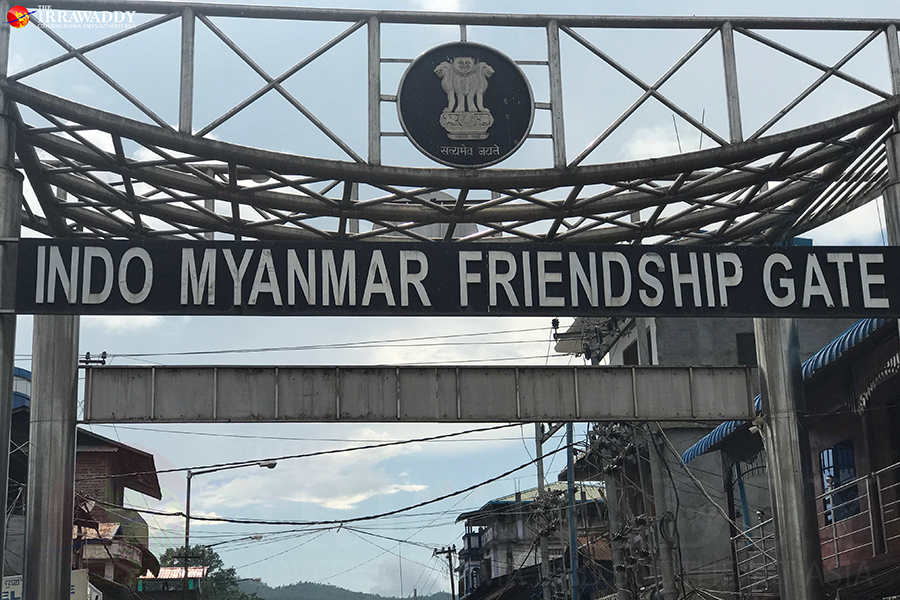Exploring The Gastronomic Links Between India And Myanmar

Table of Contents
Shared Ingredients: The Foundation of Culinary Exchange
The foundation of the culinary similarities between India and Myanmar lies in the shared ingredients that form the backbone of their respective cuisines. Centuries of trade and cultural exchange have ensured a common pantry, resulting in surprisingly similar flavor profiles.
Spices: The Aromatic Bridge
Spices are the aromatic bridge connecting Indian and Burmese cuisines. The vibrant and fragrant blends found in both countries share a remarkable overlap.
- Turmeric: Used extensively for both its flavor and vibrant color in curries, rice dishes, and pickles in both countries.
- Chili: From fiery chilies in Indian curries to the subtle heat in Burmese salads, chili peppers are a cornerstone of both cuisines, adding depth and spice.
- Ginger and Garlic: Essential aromatics that form the base of countless dishes, from Indian stir-fries to Burmese soups.
- Cumin and Coriander: These seeds provide a warm, earthy flavor to both Indian and Burmese dishes, often used in spice pastes and rubs.
- Other Spices: Commonalities extend to other spices like mustard seeds, fenugreek, and cardamom, further solidifying the shared aromatic foundation.
These spices traveled along ancient trade routes, connecting India and Myanmar through a fragrant exchange that enriched both culinary traditions. Dishes like Indian biryani and Burmese ohnokhauk swe showcase the prominent role of these shared spices.
Rice and Lentils: Staples of Both Diets
Rice and lentils are fundamental to both Indian and Burmese diets, providing a base for countless dishes and reflecting the agricultural landscapes of both regions.
- Rice: From the fragrant basmati rice of India to the glutinous rice used in Burmese mohinga, rice varieties and preparation methods are diverse yet share a central role in both cuisines.
- Lentils: Dals are a staple in Indian cooking, while Myanmar boasts similar lentil-based dishes, often incorporated into soups and stews. The versatility of lentils provides a protein-rich element in the daily meals and festive occasions of both countries.
- Significance: These staples aren't merely ingredients; they represent cultural and social significance, featuring prominently in everyday meals and celebratory feasts.
Cooking Techniques: Similarities in Preparation
Beyond shared ingredients, the cooking techniques employed in Indian and Burmese cuisine display remarkable parallels, reflecting a shared culinary heritage.
Curries and Stews: A Shared Culinary Legacy
The art of curries and stews is a shared culinary legacy. While the spice profiles and regional variations differ, the core techniques are strikingly similar.
- Mohinga (Burma) vs. Indian Curries: Compare the rich, flavorful broth of Burmese mohinga to the diverse array of Indian curries. Both utilize slow cooking methods to extract maximum flavor.
- Coconut Milk: The creamy richness of coconut milk is a common element in both cuisines, adding depth and complexity to both curries and stews.
- Layering of Flavors: Both cuisines master the art of layering flavors, building complexity through the careful addition of spices, herbs, and other ingredients. This reflects a deep understanding of flavor profiles and balanced culinary compositions.
Fermentation and Pickling: Preserving Flavors and Traditions
Fermentation and pickling techniques demonstrate a shared approach to preserving food and maintaining culinary traditions in both India and Myanmar.
- Indian Pickles and Chutneys: These iconic Indian condiments showcase the art of fermentation and pickling, adding vibrant flavors and textures to meals.
- Burmese Fermented Fish Sauces and Salads: Similar preservation methods are employed in Myanmar, particularly in the preparation of fermented fish sauces and flavorful salads.
- Environmental Factors: These preservation techniques reflect adaptation to similar environmental conditions and agricultural practices, emphasizing resourcefulness and sustainability.
Notable Dishes: Culinary Echoes Across Borders
The culinary exchange between India and Myanmar is evident in specific dishes, showcasing a fascinating interplay of influences.
Influence of Indian Cuisine on Burmese Dishes
Several Burmese dishes bear the clear imprint of Indian culinary traditions, highlighting the historical impact of Indian cuisine.
- Specific Examples: Many Burmese dishes exhibit clear Indian influences, which need specific examples to illustrate the point effectively. Further research is required to cite specific dishes and their Indian counterparts.
- Adaptation: Indian techniques and ingredients have been creatively adapted to suit Burmese tastes and preferences.
- Historical Context: This culinary borrowing reflects the historical interactions between the two countries, underscoring the depth of their relationship.
Burmese Culinary Impacts on Regional Indian Cuisine
While the influence of Indian cuisine on Myanmar is more pronounced, it’s important to consider potential reciprocal influences, particularly in Northeast India.
- Northeast India: Further research is necessary to explore potential influences of Burmese cuisine on regional dishes in Northeast India. This requires specific examples and analysis of shared ingredients or techniques.
- Two-Way Exchange: The possibility of a two-way culinary exchange suggests a more complex and dynamic relationship than previously considered.
- Historical Evidence: Finding documented historical evidence to support this reciprocal exchange would enrich our understanding of the shared culinary heritage.
Conclusion
The culinary landscape of India and Myanmar reveals a fascinating tapestry woven from shared ingredients, techniques, and historical interactions. From the aromatic spices that form the backbone of both cuisines to the similar methods of preparing curries and stews, the gastronomic links between these two nations are undeniable. By exploring these culinary connections, we gain a deeper appreciation for the rich cultural exchange that has shaped both culinary traditions.
Call to Action: Continue exploring the delicious connections between Indian and Burmese food! Discover more about the fascinating gastronomic links between India and Myanmar by researching specific dishes and exploring authentic recipes. Further your culinary journey by trying some of these delicious dishes yourself!

Featured Posts
-
 Espns Revised Nba Draft Lottery Show A Viewer Perspective
May 13, 2025
Espns Revised Nba Draft Lottery Show A Viewer Perspective
May 13, 2025 -
 Top Seeded Sabalenka Advances To Porsche Grand Prix Final
May 13, 2025
Top Seeded Sabalenka Advances To Porsche Grand Prix Final
May 13, 2025 -
 Nba Draft Lottery Sixers Odds Viewing Information And Key Details
May 13, 2025
Nba Draft Lottery Sixers Odds Viewing Information And Key Details
May 13, 2025 -
 Early Access Doom The Dark Age How Retailers Compromised The Release
May 13, 2025
Early Access Doom The Dark Age How Retailers Compromised The Release
May 13, 2025 -
 Thursday February 20th Orange County Game Scores And Player Stats
May 13, 2025
Thursday February 20th Orange County Game Scores And Player Stats
May 13, 2025
Latest Posts
-
 Renowned Cinematographer Lin Tsan Ting Dies At 94 Golden Horse Legacy Lives On
May 13, 2025
Renowned Cinematographer Lin Tsan Ting Dies At 94 Golden Horse Legacy Lives On
May 13, 2025 -
 Golden Horse Awards Winner Lin Tsan Ting A Life In Cinematography
May 13, 2025
Golden Horse Awards Winner Lin Tsan Ting A Life In Cinematography
May 13, 2025 -
 5 Of Manufacturers Prioritize Cybersecurity A 41 Point Investment Surge
May 13, 2025
5 Of Manufacturers Prioritize Cybersecurity A 41 Point Investment Surge
May 13, 2025 -
 Renowned Cinematographer And Golden Horse Awards Recipient Lin Tsan Ting Dies At 94
May 13, 2025
Renowned Cinematographer And Golden Horse Awards Recipient Lin Tsan Ting Dies At 94
May 13, 2025 -
 Golden Horse Awards Winner Lin Tsan Ting Dead At 94 A Legacy Of Cinematography
May 13, 2025
Golden Horse Awards Winner Lin Tsan Ting Dead At 94 A Legacy Of Cinematography
May 13, 2025
